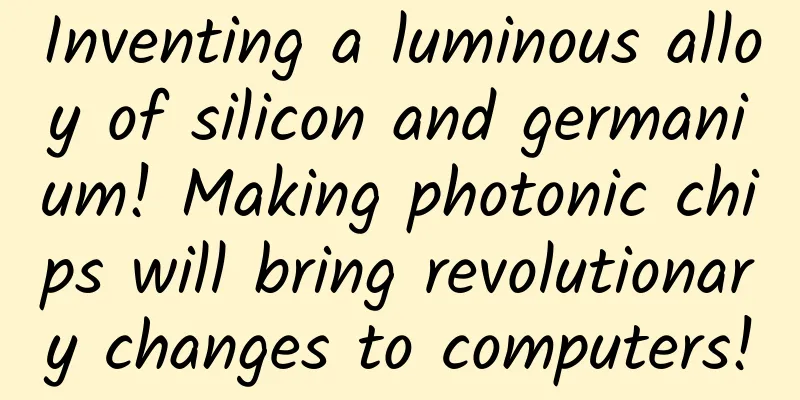Inventing a luminous alloy of silicon and germanium! Making photonic chips will bring revolutionary changes to computers!

|
[Mobile software: Bo Ke Yuan] If computers use photons instead of electrons to transmit data, they will perform better and consume less power. Scientists are currently working on a new light-emitting alloy of silicon and germanium to obtain photonic chips, which will bring revolutionary changes to computers. Photons, the particles that make up light, have basically replaced electrons for data transmission in communication networks. The high bandwidth of optical signals has driven the huge growth of telephone systems, television broadcasting and the Internet, however, photons have not yet replaced electrons in computers. Using light to carry data across processor chips and their interconnections would dramatically increase the speed of computers (communication within and between chips could be increased by a factor of 1,000) while reducing the power required to run them. Advanced microprocessor chips can contain tens of billions of transistors, and their copper electrical interconnects generate a lot of heat when they operate. Unlike photons, electrons have mass and charge. When they flow through metal or semiconductor materials, they are scattered by silicon and metal atoms, causing them to vibrate and generate heat. As a result, much of the power supplied to the microprocessor is wasted. The challenge of producing light from silicon The electronics industry is gearing up to use silicon in computer chips because of its superior electronic properties and availability. It's a good semiconductor, an abundant element, and, like silicon oxide, a component of glass and sand. However, due to silicon's crystal structure, it's not very good at processing light. For example, it can't generate photons or control their flow for data processing. Scientists have studied light-emitting materials such as gallium arsenide and indium phosphide, but their use in computers remains limited because they don't integrate well with current silicon technology. Optoelectronic chips Scientists from Europe have published in the journal Nature a new alloy of silicon and germanium that is optically active. "This is the first step. We have shown that this material is very suitable for emitting light and that it is compatible with silicon," said Jos Haverkort, a physicist at the Eindhoven University of Technology in the Netherlands. The next step is to develop a silicon-compatible laser that will be integrated into electronic circuits as a light source for optoelectronic chips, which is the ultimate goal of the SILAS project supported by the EU FET program. The team was led by Erik Bakkers of Eindhoven University and included researchers from the universities of Jena and Munich in Germany, the University of Linz in Austria, the University of Oxford in the UK and IBM University in Switzerland. To create the laser, the scientists combined silicon and germanium in a hexagonal structure that can emit light, overcoming the disadvantage of silicon, in which atoms are arranged in a cubic form. It was a difficult project, and initial attempts to coax silicon into adopting a hexagonal structure by depositing silicon atoms on a hexagonal germanium layer failed. "When silicon is grown on flat hexagonal germanium, it stubbornly refuses to change its cubic structure," explains Jonathan Finley from the Technical University of Munich. Finley was able to work out this unusual growth of silicon-germanium by measuring the optical properties of the resulting silicon samples. Over the years, however, the Eindhoven University research group had developed expertise in growing nanotubes and reasoned that what didn't work on a flat surface of germanium might work on the curved surface of a nanotube, and this time the matter was resolved. What was done was to use gallium arsenide nanowires, which have a hexagonal structure, so there's a hexagonal stem, and the researchers created a silicon shell around the core, which also has a hexagonal structure. By varying the amount of silicon and germanium deposited on the nanotubes, the researchers found that when the concentration of germanium exceeded 65 percent, this hexagonal alloy was able to emit light. The next step is the demonstration of lasing, in other words, determining how well the silicon-germanium alloy can amplify and emit light as a laser, and measuring it. There are several outstanding issues that need to be addressed before silicon germanium can be fully integrated with silicon-based electronics: First, these devices must be integrated with existing technologies, which remains a hurdle. It is expected that future quantum computers will use low-cost silicon-based LEDs, fiber lasers, light sensors, and light-emitting quantum dots, among other applications. Overall, the shift from electrical to optical communications will drive innovation in many areas, from lidar for autonomous driving to sensors for medical diagnostics or real-time air pollution detection. |
<<: Silverware is loved by many people, what is its charm?
Recommend
How to take Fritillaria cirrhosa to cure cough
Fritillaria is a common Chinese medicine. I belie...
Digging up the roots | Can blood transfusions “prolong life”? Still need to be viewed with caution
gossip Aging is a life process that everyone will...
The versatile "Lynx Car" can be equipped with various weapons and can also be transformed into an ultra-light all-terrain cooking vehicle
As a country known for its delicious food, my cou...
Side effects of bitter beans
Sophora alopecuroides is a common medicinal plant...
Sudden chest pain? People with high blood pressure should be careful! Huaxi doctors: This disease can be fatal!
Hypertensive patients, please take note If you su...
What are the effects and functions of Alpinia oxyphylla
Many people are not familiar with Alpinia oxyphyl...
The efficacy and function of Bodhisattva fish
Bodhisattva fish is a very nutritious and preciou...
What is the method of drinking black wolfberry soaked in water?
Before we use any kind of Chinese medicinal mater...
What is the medicinal value of scallops?
Abalone is a scallop product, which is usually ea...
The effect of drinking Ganoderma lucidum and American ginseng in water
Everyone may know that Ganoderma lucidum and Amer...
"Coming from South to North" What kind of eye disease is the "uveitis" that Old Wu suffers from?
Recently, the TV series "South to North"...
Effects and functions of Ilex iron
There are many Chinese medicines in our lives tha...
Constipation destroys your body and makes you socially unwell! Huaxi doctors: It is not easy to poop freely
The joys and sorrows of mankind are not the same:...
What is the meaning of life? Different interpretations at different stages
Leviathan Press: A few years ago, a friend of min...
How does the "fat drama" in the body affect our health?
Have you ever thought that there are wonderful &q...









